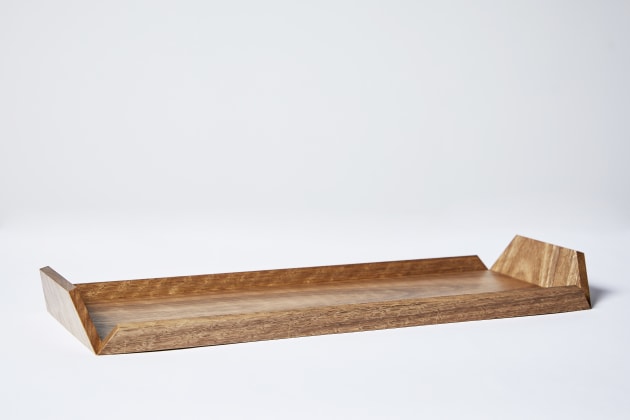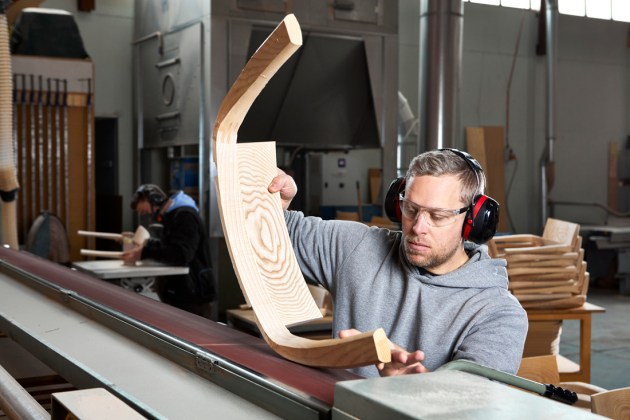Rolf Barfoed: The business of solid wood
Rolf Barfoed is a Canberra based furniture designer and maker who heads up a team of cabinetmakers crafting furniture and bespoke commissions as well as manufacturing commercially for designers and brands. We spoke to Rolf about the business of woodworking and about the things that influence his own design practice.
‘Visually simple and technically complex’ is how you described a piece made for exhibition this year and this seems to describe the style of your other recent work. How do you define visually simple? Why do you pair it with complexity?
Many of my designs use simple geometric shapes such as rectangles and squares with arcs, tapers and extrusion profiles for detail. These are common, simple shapes in furniture. They’re typical and easily produced with standard tools and machinery. The rules of timber movement guide the design and craftsmanship decisions I make. With that I’m always looking to be original with the way that I work wood. This is the complexity part. Simple woodworking solutions are less likely to be original or innovative after all these centuries of exploration.

Clarke Bedside Cabinets, Tasmanian oak, oil finished, designed and made by Rolf Barfoed
You referred to having an attitude of visual restraint in your work. Can you explain what you mean by that?
My early work echoed my training and the places I have worked at. It takes a few years to find your own style, your own methods and also priorities. By visually restrained I’m referring to the considered use of detailing. For example, I rarely combine species in my work except for small details like finger-pulls. The design narrative I follow (for now) doesn’t see the need for historic decoration. The form and function and the manner of its construction is the point of interest.

Detail of Bendora Barstool in blackwood
How would you define the aesthetic of both contemporary commercial furniture and studio furniture? Are there areas that overlap? Who do you mainly make for?
As a craftsman for other designers, when I’m given plans from a (non- maker) designer, I often have to figure out a way to build the furniture to achieve the end result as per the plans. Occasionally the plans have to be modified to suit our equipment. The designs are often naive to the rules of timber furniture making and/ or no care is given to the feasibility
of making it commercially. This can be challenging and a lot of R&D is needed to bring the piece into production, but it can also lead to innovation in how we use our skills and tools. Our job is to figure out how to present timber to machines and tools. This is a great way to design original furniture and the ingenuity in these designs creates a curious aesthetic that a woodworker can usually see from a mile away. I’m often inspired by these designs.
When designing, as a maker, I find it almost impossible to ignore my knowledge of timber and how to work it. It takes a huge effort to develop a concept that I don’t knowing how to make. This can make it hard to be original. Designer/maker style
is rooted in traditional skills and techniques (an existing framework).
Quality comes down to what the client is willing to pay for. This is not necessarily a design vs craft priority. Many studio furniture makers work to standards lower than those of my commercial clients. Over half of our work is for other designers. We’re happy to develop prototypes, make bespoke designs and bring designs into small scale production.


Rolf Barfoed’s Exo Desk received a design award at AWR Studio Furniture 2018 and was ‘...designed around an awareness of material economy and modern fabrication methods.’
Achieving visual simplicity is one thing, but time is money – how do you justify technical complexity in a commercial situation?
It’s an ongoing challenge to balance complexity with experience, skill level and the expense of the business overheads. All team members are aware of the equation that makes up our overhead, so everyone is invested in their project and the importance of being productive. I try to feature only one complex element in each design. That’s enough to separate it from generic furniture and to challenge the craftsman.

Rolf Barfoed’s Round Table in Australian red cedar features a resawn veneer top, a ring laminated rim and bridle joints.
Where did you train? Did you have other career inclinations?
I did a cabinetmaking apprenticeship with a small family business in Canberra. We made commercial work, timber furniture and did antique restoration. I was lucky to see such a wide variety of work in the otherwise kitchen manufacturing dominated industry. I attended the Canberra Institute of Technology (CIT) for three years through this period. This was an incredible time for me and like most woodworkers I was totally obsessed. While training I also read Wood Review and Fine Woodworking which informed my move towards studio furniture rather than commercial cabinetmaking.
In 2009 I went to England on a scholarship via success in the national WorldSkills competition. There, I worked for Richard Williams in Beaconsfield. In 2010 I returned to my former job at Dunstone Design where I stayed for four years before establishing my own studio. I learned so much working at these two businesses.
I always wanted to be a woodworker when I was a kid. My parents empowered that. I had my own woodworking bench under the pergola with tools and off-cuts from the local window manufacturer to practise with.

Workshop team: Sam Ryrie (apprentice), Tim Bishell (cabinetmaker), Rolf Barfoed, Nathan Cummins (cabinetmaker), Vivien Clarke (assistant), Elliot Bastianon (assistant).
A couple of years ago you moved into larger premises and took on staff? Was that a hard leap to make? How did you get started?
We were overdue to move into larger premises when we did. My first workshop would not have accommodated more than one maker. Canberra has a high population of good woodworkers. Of the 240 cabinetmakers and joiners in the Canberra region I can name about ten that do solid timber work and I had a list of people who had shown interest in working for me over the years.

Folded Trays with chevron corners in spotted gum, produced in batches for gallery sale
Are you still sharing space and equipment? Have their been other benefits to sharing?
I established my first workshop in 2014. It was 80m2 and adjoined a 140m2 share workshop (SixWiluna) which had four tenants. We outgrew the place way before I signed the lease to a 540m2 workshop that we moved into in 2017. Signing a big lease is nerve-racking but it was made easier knowing the rent would be shared between four tenants. The workshop has since reduced to my team plus two tenants. We still have loads of progress planned for the space.
In the workshop we come from a mix of backgrounds of apprenticeships, uni degrees and short courses at renowned woodworking schools. This has brought many different values and opinions together in the one place. We’ve held a group exhibition annually with Design Canberra for the last four years. We behave more like colleagues than competing furniture makers.

The Barrington Tops Bookcase, Australian red cedar, detail and full view images. Sculpted curves highlight the wood grain.
Is working on a larger scale and running a more complex business taking you off the bench so to speak? How do you feel about that?
I work about 50 hours a week. I aim to be on the bench for 10 to 20 hours a week. All the other time vanishes into the ether. I prefer being on the bench but preparing work for the team is part of the bigger plan to have a less self-dependent business. I still do most of the R&D for our production work. More and more the team are improving and leading projects.
Do you enjoy systems and managed production processes? I get the feeling there’s some joy in that for you. How do you approach a large job?
For my own work I try to design according to the experience level of my team. At the beginning of each project the craftsperson and I carefully predict and list the entire build process as well as considering allocated target times. There are many ways to achieve the correct result. I want this to happen with as little risk and in the fastest manner possible. We always make a process as risk free as possible with machinery and jigs. Usually we can foresee trouble, however complex cabinets have undone us more than once.
I’m slowly developing a process and pricing spreadsheet for chairmaking, so that we can be as precise as possible when quoting. The team is very disciplined at recording time on each project we make. We’ve fully itemised the process for each chair we make.
What are the biggest challenges you face in your business? Are they technical, personal or...?
Cash flow rules everything around me. Big workshop, big team, big overheads. We’ve had a backlog of work for a long time but we’re nearing the end of that. We have about 100 hours of productive labour to sell each week.I’m still finding my groove as an employer and teacher for my team. I’m learning to be as patient and available as possible while doing my load of the work as well.
Where are you going with all this? Where do you want to be in 5 or 10 years time? What are your aims for the business and for your team?
This is more than a job, but I do want to only work for five days a week, where my team and I have a good time, doing what we want to do and with each of us making a fair income with the opportunity for progress. The decision to expand and have a team is a way to grow, pass on skills and share the burden of the overheads.
I really enjoy small scale production furniture making and my idols in this space are PP Møbler, Carl Hansen and Sons, and Ercol. They make high-end furniture for their own brands and for other designers. They also produce incredible craftspeople. A combination of production and bespoke work makes for a fun mix of modern and traditional craftsmanship. Our existing lease expires in only a couple of years. I’d love to eventually own premises with a showroom and upgraded machinery, constantly developing new work and my own brand.
2020 has been wild – so far. First the bushfires, then a hailstorm (that wrote- off everyone’s car at the workshop) and now the COVID-19 setback makes for a slightly unpredictable future. I hope that Australians can band together and we all get through this time intact.

Rolf Barfoed on the cover of the issue of AWR this interview appeared in.
At the end of the day, what means the most to you about the things you design and make?
I’m still chasing the dream. Searching for my signature; a distinct cabinetmaker’s aesthetic. My furniture should be innovative, useful, and easy to live with. Developing a recognisable style takes persistence and I’m working towards a bigger body of work.
First published in Australian Wood Review issue 108, 2020
Learn more about Rolf Barfoed at www.rolfbarfoed.com.au and Instagram @rolfbarfoed
Photos: Light Bulb Studio, ACT





